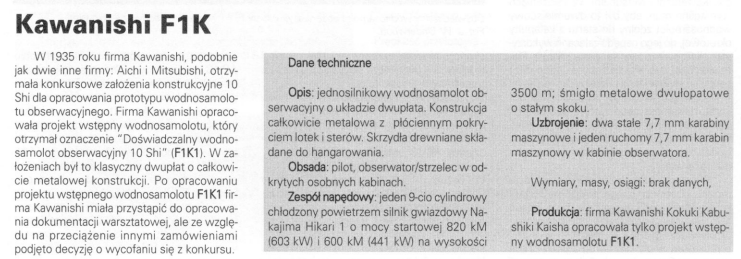Zero Observation Aircraft
Mitsubishi Zero observation aircraft was a two-seat surface observation aircraft of the Japan Navy. The Allies used to call her by the code name "Pete."
In naval battles, when the range of gunfire exceeded 30,000 meters, it became difficult to hit enemy ships because of the inaccuracy of projectile impact observations from the water. Therefore, the Navy thought of obtaining accurate bullet landing information by observing the impact from the air and giving it a hit bullet , and the observation aircraft was developed for that purpose
The observation aircraft did not require a long range, but they did need air combat capability to eliminate some enemy planes that interfered with them.
The Navy ordered three companies, Mitsubishi Heavy Industries, Aichi Aircraft, and Kawanishi Aircraft, to build prototypes of the observation aircraft under the name of "10 Experimental Surface Observation Aircraft". However, Kawanishi soon dropped out, and prototypes were made with Mitsubishi and Aichi.
The Mitsubishi prototype was superior to the Aichi prototype in air combat performance, but it was 60 km/h behind the Aichi prototype in speed. Mitsubishi thought that it would be at a disadvantage if this situation continued, so hurriedly built a prototype with a new engine, and the speed difference was reduced to 25 km/h.
As a result of the examination, the Mitsubishi aircraft was adopted, and in December 1940 it was formalized as the "Zero Type 1 Observation Aircraft Type 1".
In the Pacific War, there was not much surface combat, so it was rarely used as an observation aircraft, which was its original mission, and was mainly used for reconnaissance and anti-submarine patrols. In addition, he used his excellent air combat performance to engage in air battles with F4Fs and SBDs, and shot them down.
By 1943, 608 Zero observation aircraft had been produced, of which 528 were produced by Mitsubishi and 180 by Sasebo Arsenal.
In 1942, the name of this aircraft was changed to "Zero Type 11".
 AICHI_F1A_3_SIDE_DRAWING_2.jpg112.7 KB · Views: 520
AICHI_F1A_3_SIDE_DRAWING_2.jpg112.7 KB · Views: 520 MITSUBISHI F1M.jpg55.3 KB · Views: 138
MITSUBISHI F1M.jpg55.3 KB · Views: 138 F1M prototype.jpg49.1 KB · Views: 116
F1M prototype.jpg49.1 KB · Views: 116 r48-7.jpg163.8 KB · Views: 110
r48-7.jpg163.8 KB · Views: 110 Mitsubishi F1M.jpg32.2 KB · Views: 142
Mitsubishi F1M.jpg32.2 KB · Views: 142 F1M2.jpg51.1 KB · Views: 446
F1M2.jpg51.1 KB · Views: 446 LAND BASE F1A.jpg28.1 KB · Views: 446
LAND BASE F1A.jpg28.1 KB · Views: 446 Aichi F1A land base version.jpg40.1 KB · Views: 468
Aichi F1A land base version.jpg40.1 KB · Views: 468 F1A1.jpg48.5 KB · Views: 479
F1A1.jpg48.5 KB · Views: 479


